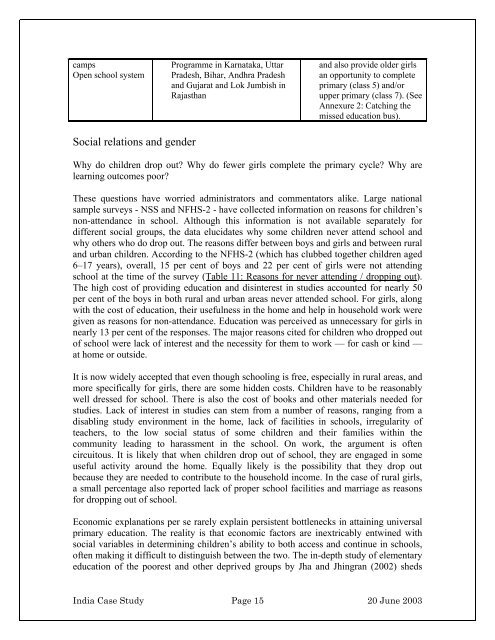Where are we today with respect to girls' education
Where are we today with respect to girls' education
Where are we today with respect to girls' education
- No tags were found...
You also want an ePaper? Increase the reach of your titles
YUMPU automatically turns print PDFs into web optimized ePapers that Google loves.
campsOpen school systemProgramme in Karnataka, UttarPradesh, Bihar, Andhra Pradeshand Gujarat and Lok Jumbish inRajasthanand also provide older girlsan opportunity <strong>to</strong> completeprimary (class 5) and/orupper primary (class 7). (SeeAnnexure 2: Catching themissed <strong>education</strong> bus).Social relations and genderWhy do children drop out? Why do fe<strong>we</strong>r girls complete the primary cycle? Why <strong>are</strong>learning outcomes poor?These questions have worried administra<strong>to</strong>rs and commenta<strong>to</strong>rs alike. Large nationalsample surveys - NSS and NFHS-2 - have collected information on reasons for children’snon-attendance in school. Although this information is not available separately fordifferent social groups, the data elucidates why some children never attend school andwhy others who do drop out. The reasons differ bet<strong>we</strong>en boys and girls and bet<strong>we</strong>en ruraland urban children. According <strong>to</strong> the NFHS-2 (which has clubbed <strong>to</strong>gether children aged6–17 years), overall, 15 per cent of boys and 22 per cent of girls <strong>we</strong>re not attendingschool at the time of the survey (Table 11: Reasons for never attending / dropping out).The high cost of providing <strong>education</strong> and disinterest in studies accounted for nearly 50per cent of the boys in both rural and urban <strong>are</strong>as never attended school. For girls, along<strong>with</strong> the cost of <strong>education</strong>, their usefulness in the home and help in household work <strong>we</strong>regiven as reasons for non-attendance. Education was perceived as unnecessary for girls innearly 13 per cent of the responses. The major reasons cited for children who dropped ou<strong>to</strong>f school <strong>we</strong>re lack of interest and the necessity for them <strong>to</strong> work –– for cash or kind ––at home or outside.It is now widely accepted that even though schooling is free, especially in rural <strong>are</strong>as, andmore specifically for girls, there <strong>are</strong> some hidden costs. Children have <strong>to</strong> be reasonably<strong>we</strong>ll dressed for school. There is also the cost of books and other materials needed forstudies. Lack of interest in studies can stem from a number of reasons, ranging from adisabling study environment in the home, lack of facilities in schools, irregularity ofteachers, <strong>to</strong> the low social status of some children and their families <strong>with</strong>in thecommunity leading <strong>to</strong> harassment in the school. On work, the argument is oftencircui<strong>to</strong>us. It is likely that when children drop out of school, they <strong>are</strong> engaged in someuseful activity around the home. Equally likely is the possibility that they drop outbecause they <strong>are</strong> needed <strong>to</strong> contribute <strong>to</strong> the household income. In the case of rural girls,a small percentage also reported lack of proper school facilities and marriage as reasonsfor dropping out of school.Economic explanations per se r<strong>are</strong>ly explain persistent bottlenecks in attaining universalprimary <strong>education</strong>. The reality is that economic fac<strong>to</strong>rs <strong>are</strong> inextricably entwined <strong>with</strong>social variables in determining children’s ability <strong>to</strong> both access and continue in schools,often making it difficult <strong>to</strong> distinguish bet<strong>we</strong>en the two. The in-depth study of elementary<strong>education</strong> of the poorest and other deprived groups by Jha and Jhingran (2002) shedsIndia Case Study Page 15 20 June 2003












